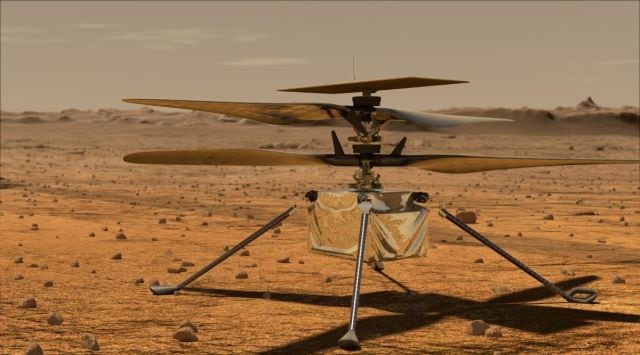NASA video shows Ingenuity Mars Helicopter on a daring record-breaking flight
The NASA video shows the Ingenuity Mars helicopter completing its record-breaking 25th flight where it covered a distance of 704 metres at a speed of 5.5 metres per second,
 An illustration of NASA’s Ingenuity Helicopter on the Martian surface. (Image credit: NASA)
An illustration of NASA’s Ingenuity Helicopter on the Martian surface. (Image credit: NASA)NASA has published dramatic footage of the Ingenuity Mars helicopter completing its record-breaking 25th flight where the helicopter covered a distance of 704 metres at a speed of 5.5 metres per second, marking the rotorcraft’s longest and fastest flight to date. The video was taken on April 8 during the flight but was only released by the space agency on May 27.
Ingenuity is a small solar-powered helicopter that landed on the surface of Mars on February 18, 2021, along with the Perseverance Rover. It completed the world’s first powered extraterrestrial flight on April 19 when it took off, hovered and landed for a flight duration of 39.1 seconds.
An aerial view from Mars.
During #MarsHelicopter’s 25th flight, it flew 2,310 ft (704 m) at a speed of 12 mph (5.5 m/s), breaking its own distance and groundspeed records on another planet. Imagery recently downlinked shows Ingenuity’s point of view. https://t.co/NU5d6wGSdE pic.twitter.com/IqgkEmR04W— NASA JPL (@NASAJPL) May 28, 2022
“For our record-breaking flight, Ingenuity’s downward-looking navigation camera provided us with a breathtaking sense of what it would feel like gliding 33 feet above the surface of Mars at 12 miles per hour,” said Ingenuity team lead Teddy Tzanetos of NASA’s Jet Propulsion Laboratory in Southern California, in a press statement.
The video clip starts about one second into the flight. The rotorcraft reaches an altitude of 10 metres and heads southwest, accelerating to its maximum speed in less than three seconds. It first flew over a group of sand ripples and some rock fields. Towards the end, a flat and featureless terrain appears, providing a good landing spot for Ingenuity. The approximately 162 seconds long flight footage was sped up about five times, reducing the video’s length to less than 35 seconds.
The rotorcraft’s navigation camera has been programmed to deactivate whenever the rotorcraft is within 1 metre of the surface. This is to ensure that any dust kicked up during takeoff and landing doesn’t interfere with the navigation system as it tracks geographical features on the ground.
Earlier this month, NASA had announced that it had momentarily lost contact with the helicopter after it entered a low-power state. It later got back in contact after getting adequate energy from its solar array; helping it charge its six lithium-ion batteries.







